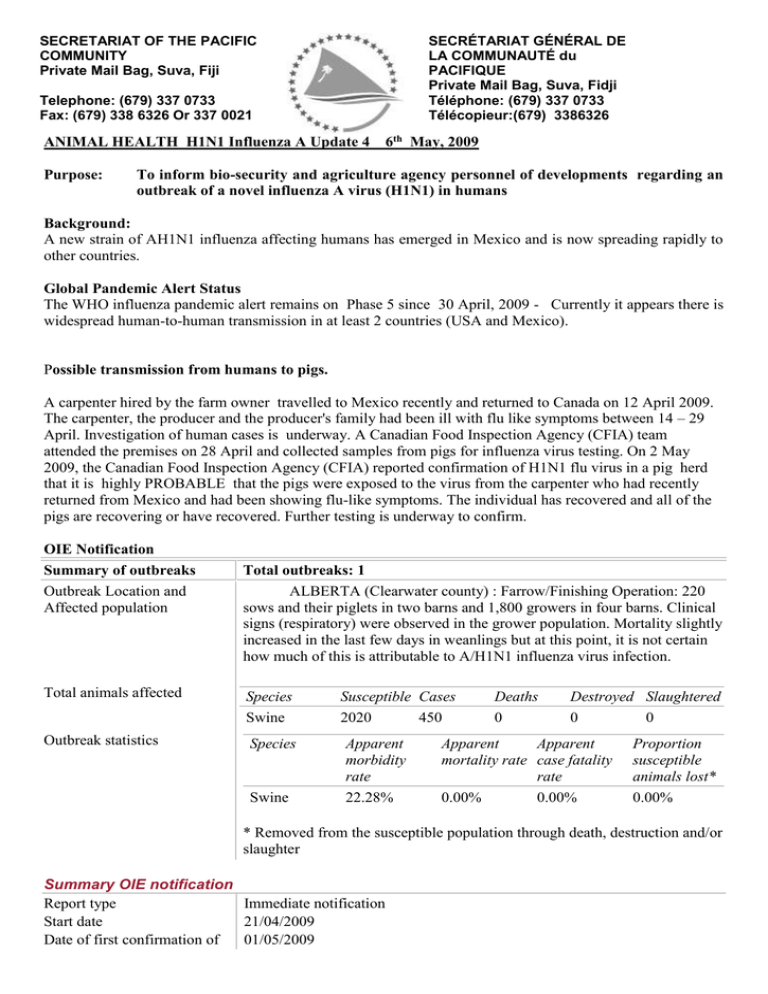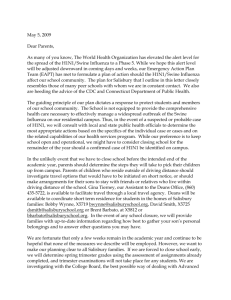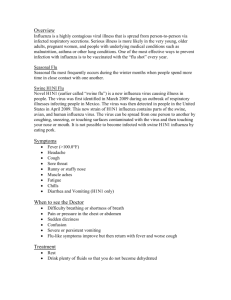SECRETARIAT OF THE PACIFIC SECRÉTARIAT GÉNÉRAL DE COMMUNITY LA COMMUNAUTÉ du
advertisement

SECRETARIAT OF THE PACIFIC COMMUNITY Private Mail Bag, Suva, Fiji SECRÉTARIAT GÉNÉRAL DE LA COMMUNAUTÉ du PACIFIQUE Private Mail Bag, Suva, Fidji Téléphone: (679) 337 0733 Télécopieur:(679) 3386326 Telephone: (679) 337 0733 Fax: (679) 338 6326 Or 337 0021 ANIMAL HEALTH H1N1 Influenza A Update 4 Purpose: 6th May, 2009 To inform bio-security and agriculture agency personnel of developments regarding an outbreak of a novel influenza A virus (H1N1) in humans Background: A new strain of AH1N1 influenza affecting humans has emerged in Mexico and is now spreading rapidly to other countries. Global Pandemic Alert Status The WHO influenza pandemic alert remains on Phase 5 since 30 April, 2009 - Currently it appears there is widespread human-to-human transmission in at least 2 countries (USA and Mexico). Possible transmission from humans to pigs. A carpenter hired by the farm owner travelled to Mexico recently and returned to Canada on 12 April 2009. The carpenter, the producer and the producer's family had been ill with flu like symptoms between 14 – 29 April. Investigation of human cases is underway. A Canadian Food Inspection Agency (CFIA) team attended the premises on 28 April and collected samples from pigs for influenza virus testing. On 2 May 2009, the Canadian Food Inspection Agency (CFIA) reported confirmation of H1N1 flu virus in a pig herd that it is highly PROBABLE that the pigs were exposed to the virus from the carpenter who had recently returned from Mexico and had been showing flu-like symptoms. The individual has recovered and all of the pigs are recovering or have recovered. Further testing is underway to confirm. OIE Notification Summary of outbreaks Outbreak Location and Affected population Total outbreaks: 1 ALBERTA (Clearwater county) : Farrow/Finishing Operation: 220 sows and their piglets in two barns and 1,800 growers in four barns. Clinical signs (respiratory) were observed in the grower population. Mortality slightly increased in the last few days in weanlings but at this point, it is not certain how much of this is attributable to A/H1N1 influenza virus infection. Total animals affected Species Swine Outbreak statistics Species Swine Susceptible Cases 2020 450 Apparent morbidity rate 22.28% Deaths 0 Destroyed Slaughtered 0 0 Apparent Apparent mortality rate case fatality rate 0.00% 0.00% Proportion susceptible animals lost* 0.00% * Removed from the susceptible population through death, destruction and/or slaughter Summary OIE notification Report type Immediate notification Start date 21/04/2009 Date of first confirmation of 01/05/2009 the event Report date Date submitted to OIE Reason for notification Morbidity Mortality 02/05/2009 05/05/2009 Emerging disease 25 % 0% Statements from Chief Veterinary Officer of FAO "The human-to-animal transmission that occurred in Canada does not come as a surprise as influenza viruses are capable of transmitting from humans to animals," "The Canadian event should therefore not be a matter of panic, but it should remind us of the human-animal link in virus transmission on which we definitely need to keep an eye." Influenza viruses, whether in humans or among animals, are constantly evolving genetically, along with changes in their ability to cause morbidity and mortality in humans or animals. Therefore the current A/H1N1 situation should be carefully monitored as many of the virus characteristics and developments are still unknown. Recommended Priority Actions – FAO National authorities are encouraged to carefully investigate possible occurrences of Influenza-like events in domestic animals. Virus samples may be collected and sent to national labs and/or international reference centres. National authorities can always get in touch with FAO, and by contacting EMPRES-ShippingService@fao.org, avail of support for transporting samples for laboratory testing. In order to reduce the risk for transmission of influenza A/H1N1 (humans-to-animals or animals-to-animals), FAO recommends the following: Case definitions for suspect and probable cases should be developed in collaboration with animal health partners and disseminated widely. Outbreak investigation protocols and laboratory sampling procedures should also be developed and disseminated to all veterinary professionals. Surveillance for porcine respiratory disease should be intensified and all cases of porcine respiratory syndrome should be immediately reported to the national veterinary authorities. The International Organizations -- OIE and FAO -- should be informed when presence of the new A/H1N1 Influenza virus is confirmed. Movement restrictions should be implemented for all farms or holdings with swine showing signs of clinical respiratory illness until diagnosis of the illness have been made. Where influenza A/H1N1 is confirmed, these restrictions should be in force until seven days after the last animal has recovered. Animals suffering from swine influenza can be separated from healthy herd-mates and allowed to recover; there is no need to cull affected animals. Animal handlers and veterinarians should wear protective gear to minimize risk of being infected by zoonotic agents, including influenza. Persons who work directly with swine should be urged not to go to work if they have any signs respiratory disease, fever or any influenza-like illness. Countries to closely monitor H1N1 in pigs Any influenza-like symptoms in pigs should be reported national authorities and farmers to carefully monitor pigs and investigate any possible occurrences of influenza-like symptoms in domestic animals. Persons who work directly with swine should be urged not to go to work if they have any signs of respiratory disease, fever or any influenza-like illness. Animal handlers and veterinarians should wear protective clothing to minimize the risk of being infected. Maintain close communication and collaboration with public health counterparts in country, and readiness to support their operations in any way reasonably possible. In collaboration with Health quarantine and other border control agencies intensify awareness to incoming travellers including profiling high risk travellers as well as post-entry surveillance of travellers, being key objectives of strengthened border protection measures Advise the public and public health counterparts to take all necessary steps to ensure that sick people are isolated from close contact with animals, particularly pigs and birds. Adopt good personal hygiene practices such as frequent hand-washing with soap and water and covering nose and mouth and turning away from close contacts when coughing and sneezing, personal distancing (eg. standing 2 M apart when conversing, particularly with sick people; not shaking hands as a greeting when sick), good laundry practices, masks for sick people, etc. International Spread The situation appears to be still evolving rapidly and as of 4th May, 2009, 21 countries have now reported confirmed cases. Animal Health and Bio-security Implications Surveillance for porcine respiratory disease should be intensified and all cases of porcine respiratory syndrome are recommended to be immediately reported to veterinary authorities. It is also recommended to inform OIE and FAO about any occurrence of outbreaks of the new A/H1N1 Influenza virus in pigs. Strict biosecurity measures including restriction of movements of pigs, goods and people should be applied on all farms or holdings with swine showing signs of clinical respiratory illness until diagnosis of the illness has been made. Where A/H1N1 influenza is confirmed, movement restrictions should be in force for seven days after the last animal has recovered. Governments are requested to provide full support in improving biosecurity measures particularly to small and medium pig farmers. Persons who work directly with swine should be urged not to go to work if they have any signs of respiratory disease, fever or any influenza-like illness. Animal handlers and veterinarians should wear protective clothing to minimize the risk of being infected. Joint FAO/WHO/OIE/WTO Statement on influenza A(H1N1) and the safety of pork In light of the spread of influenza A(H1N1), and the rising concerns about the possibility of this virus being found in pigs and the safety of pork and pork products, we stress that pork and pork products, handled in accordance with good hygienic practices recommended by the WHO, FAO, Codex Alimentarius Commission and the OIE, will not be a source of infection. To date there is no evidence that the virus is transmitted by food. There is currently therefore no justification in the OIE Terrestrial Animal Health Standards Code for the imposition of trade measures on the importation of pigs or their products. However it is important that Veterinary Authorities should collaborate with human health counterparts to monitor pig herds for any signs of unusual illness with suspected linkages to human cases of A(H1N1) influenza. There is no need to slaughter animals in view of preventing circulation of the A/H1N1 virus. A/H1N1 virus cannot be transmitted to humans by pork and pork products. There is also no risk of infection from this virus through consumption of well-cooked pork and pork products. Individuals are advised to wash hands thoroughly with soap and water on a regular basis when preparing food for human consumption and should seek medical attention if they develop any symptoms of influenza-like illness. Pharmaceutical Measures The existing Human AH1N1 seasonal influenza vaccine are not protective against infection with this new AH1N1 influenza strain. The new flu virus strain (H1N1 Influenza A) is quite different from the existing human AH1N1 seasonal influenza strains. Tamiflu and Relenza are effective against the new flu strain if treatment is initiated early in the disease phase . SUMMARY About 21 countries have now confirmed infection as per Table below Most cases outside Mexico are mild cases with people recovering. List of cases as of 5 May, 2009 Countries 1Mexico 2USA 3Canada 4UK 5New Zealand 6Spain 7Germany 8Switzerland 9Austria 10Netherland 11Israel 12China (HK) 13 Rep Korea 14France 15Denmark 16Costa Rica 17 Colombia 18 El Salvador 19 Italy 20 Ireland 21 Portugal Confirmed cases 822 403 140 18 6 57 8 1 1 1 4 1 1 4 1 1 1 2 2 1 1 Deaths 25 2 0 0 0 0 0 0 0 0 0 0 0 0 0 0 0 0 0 0 0 Mortality % 4 0.4 0 0 0 0 0 0 0 0 0 0 0 0 0 0 0 0 0 0 0 Note: Large increase in numbers of confirmed cases from US, Mexico, Canada and Spain AREAS WITH CONFIRMED CASES OF NEW INFLUENZA A/H1N1 VIRUS 04/05/2009 Notes: All US State, Canadian Province and international Country-level data are official WHO or CDC data. Every attempt has been made to accurately determine more precise locations of Affected Areas, but these locations are not official. AUSTRIA Vienna CANADA ALBERTA o Calgary o Edmonton o Northern Alberta BRITISH COLUMBIA o Northern BC o Vancouver o Victoria MANITOBA o Brandon NOVA SCOTIA o Windsor NEW BRUNSWICK o Fredericton ONTARIO o Peel Region o Toronto Area QUEBEC o Montreal CHINA Hong Kong COLOMBIA Zipaquira COSTA RICA San Jose DENMARK Copenhagen EL SALVADOR San Salvador FRANCE Paris GERMANY Hamburg Bavaria State IRELAND Unspecified (East) ISRAEL Holon Kfar Saba Netanya Tel Aviv ITALY Massa Carrara Rome MEXICO Aguascalientes State Baja California State Cancun Chiapas State Chihuahua State Colima State Durango State Guanajuato State Guerrero State Hidalgo State Matamoros Mexico City Federal District Mexico State Michoacan State Oaxaca State Puebla State Queretaro State San Luis Potosi Sonora Tabasco Tamaulipas Tlaxcala Veracruz State Zacatecas NETHERLANDS Aalten NEW ZEALAND Auckland SOUTH KOREA Kwacheon SPAIN Andalucia Aragon Basque Catalonia Castilla-La Mancha Galicia Madrid Murcia Valencia SWITZERLAND Baden UNITED KINGDOM ENGLAND o Barnet o Chipping Sodbury o Devon o Gloucestershire o Liverpool o London Area o Merseyside o Oxfordshire o Newcastle o Paignton o Redditch SCOTLAND o Ayrshire o Polmont USA ALABAMA o Madison ARIZONA o Phoenix o Pima County CALIFORNIA o Camp Pendleton o Imperial County o Los Angeles County o Marin o Oxnard o Riverside County o Sacramento County o San Diego County o San Francisco o San Luis Obispo County o San Bernardino Cty. (Twentynine Palms Military Base) COLORADO o Arapahoe County o Douglas County o Jefferson County CONNECTICUT o Middlesex County o Stratford DELAWARE o Newark County FLORIDA o Broward County o Lee County o Orlando GEORGIA o La Grange ILLINOIS o Chicago o DuPage County INDIANA o Marion County KANSAS o Dickinson County MASSACHUSETTS o Barnstable County o Middlesex County o Plymouth County MICHIGAN o Livingstone County o Ottawa County MINNESOTA o Stearns County MISSOURI o Platte County NEVADA o Washoe County NEW HAMPSHIRE o Merrimack County NEW JERSEY o Bergen County o Burlington County o Monmouth County NEW MEXICO o Valencia County NEW YORK o New York City o Syracuse OHIO o Franklin County o Lorain County RHODE ISLAND o Westerly SOUTH CAROLINA o Newberry County TENNESSEE o Knox County TEXAS o Cameron County o Collin County o Comal County o Corpus Christi o Dallas County o Denton County o Fort Bend o Guadalupe County o Harris County o Houston o Johnson County o Starr County o Tarrant County UTAH o Summit County VIRGINIA o Chesterfield o Northern Neck o Rockbridge County WISCONSIN o Adams County o Milwaukee County 6


